Thermal Imaging Buying Guide
The Night Master team has a unique understanding of technology in fieldsports and wildlife observation that cannot be replicated by others. As an indepent family-owned business, based in North Yorkshire, Angie, Tony and Tom have combined decades of technical expertise in night vision and thermal imaging.
Not sure which thermal suits you best? We work with leading thermal brands such as Pulsar, Pixfra and HIKMICRO offering a range of high-quality devices for detecting and identifying heat signatures in any environment.
To help you navigate the world of thermal optics, we’ve put together this guide to explain key terms such as NETD, field of view, lens size, refresh rate, and more. Whether you’re new to thermal imaging or looking to upgrade, this guide will ensure you have all the knowledge needed to choose the right device for your needs.
Why Choose Thermal Imaging?
Thermal imaging is an essential tool for wildlife observation, conservation, and fieldsports. Unlike traditional optics, thermal cameras detect heat rather than visible light, allowing you to see animals in complete darkness and through obstacles like fog, light brush, or light rain.
Whether tracking nocturnal species, surveying habitats, or spotting game, thermal imaging provides an advantage by making animals stand out against their surroundings.
What is the Difference Between Night Vision and Thermal Imaging?
Both night vision and thermal imaging enhance visibility in low-light conditions, but they work differently:
- Night Vision amplifies available light (such as moonlight or infrared illumination) to create a visible image. While it provides a more detailed, natural-looking image, it struggles in total darkness and cannot see through foliage or mist.
- Thermal Imaging detects infrared heat, allowing you to see warm-blooded animals regardless of lighting conditions. It works in complete darkness, fog, and light brush, making it ideal for tracking wildlife and spotting hidden animals.
- For wildlife observation and fieldsports, thermal imaging is often the better choice for detecting animals in challenging environments, although night vision can be useful for identifying details such as antlers or terrain features when some ambient light is available.
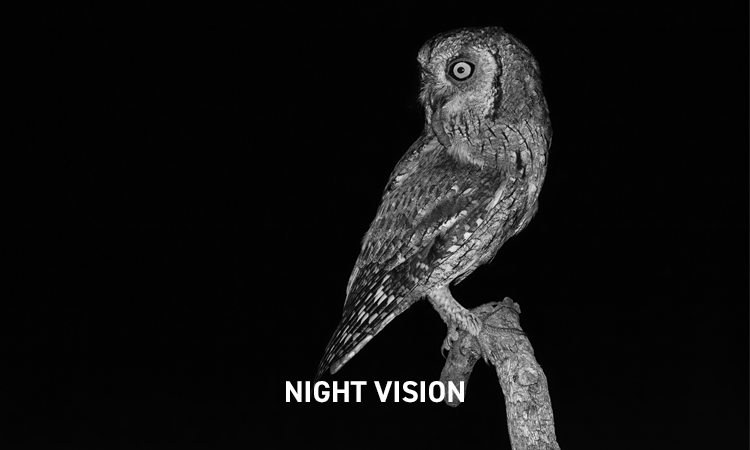
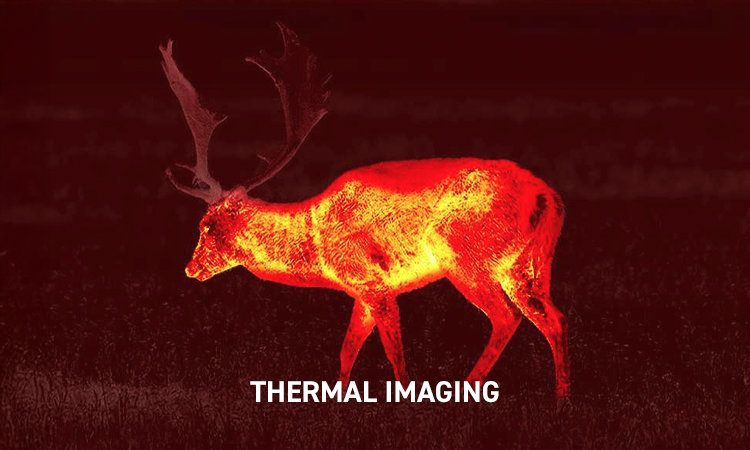
Why Does Lens Size Matter?
The lens size of a thermal camera determines the image it captures, affecting both image clarity and detection range.
- Smaller lenses (e.g. 10mm) offer a wider field of view, making them ideal for scanning forests, spotting animals at close range, and conducting surveys.
- Larger lenses (e.g. 50mm) provide greater detail at long distances, which is useful for spotting wildlife across open fields or monitoring large areas from a distance.
If you need to quickly scan broad landscapes, a smaller lens is better. If your priority is long-range identification, go for a larger lens.
Why Does Field of View Matter?
Field of view (FOV) determines how much of the scene you can see at once.
- A wide FOV is useful for habitat surveys, tracking moving animals, and quickly scanning large areas.
- A narrow FOV provides greater magnification for spotting and identifying animals at long distances.
For fieldsports and wildlife monitoring, balancing FOV and magnification ensures the best view of your surroundings. We have found that our fieldsports customers tend to go for a more narrow field of view for longer detection, while our ecology customers prioritise a wider field of view to help monitor barns, buildings, etc.
Understanding Field of View in Thermal Imaging
Field of View (FOV) refers to the width of the scene visible through a thermal imaging device at any given moment. It’s typically measured in degrees (°) and is determined by the lens size and sensor type.
Narrow Field of View (≤15° FOV)
- Typically found in long-range thermal optics with larger lenses (e.g., 50mm+).
- Provides higher magnification and more detail at long distances.
- Ideal for spotting and identifying wildlife or game across open fields, hills, or large landscapes.
Example: A 6° FOV would allow for long-range detection but would require more scanning to cover a larger area.
Wide Field of View (≥20° FOV)
- Found in short-range or scanning thermal optics with smaller lenses (e.g., 10mm-25mm).
- Provides broader area coverage but with less magnification.
- Best for tracking moving animals, scanning forests, or observing habitats up close.
Example: A 30° FOV allows you to see a much larger portion of a scene, making it easier to spot multiple animals at once.
In conclusion if your priority is detailed identification at long distances, go for a narrower FOV (e.g., ≤15°). However if you need to scan large areas quickly for surveying or track fast-moving animals, a wider FOV (e.g., ≥20°) is more practical.
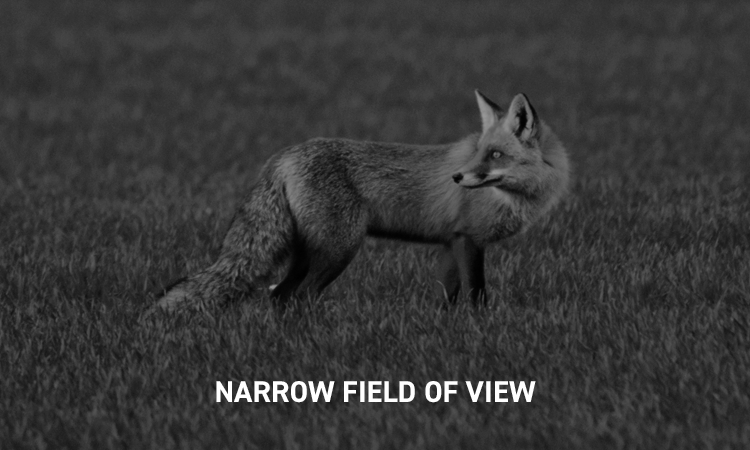
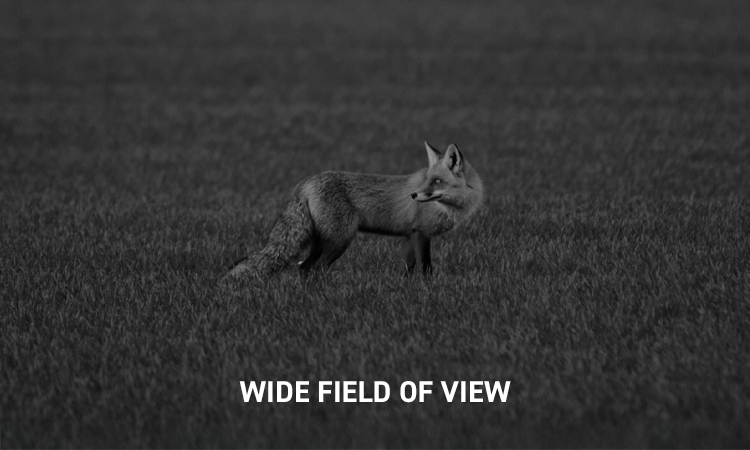
What is NETD? (Thermal Sensitivity)
NETD (Noise Equivalent Temperature Difference) measures how sensitive a thermal sensor is to detecting small temperature differences. A lower NETD value (e.g. <40mK) means the camera can detect even the smallest heat variations, improving contrast and clarity.
This is especially important in early morning mist, cold environments, or damp conditions, where spotting camouflaged or distant wildlife can be challenging. A lower NETD ensures better visibility and clearer thermal images.
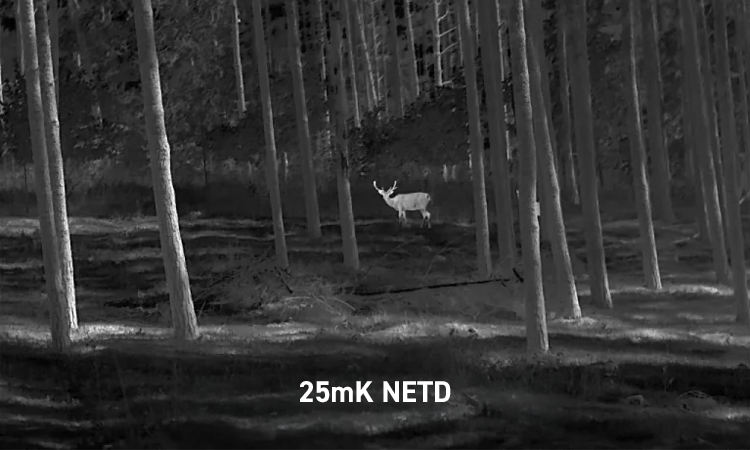
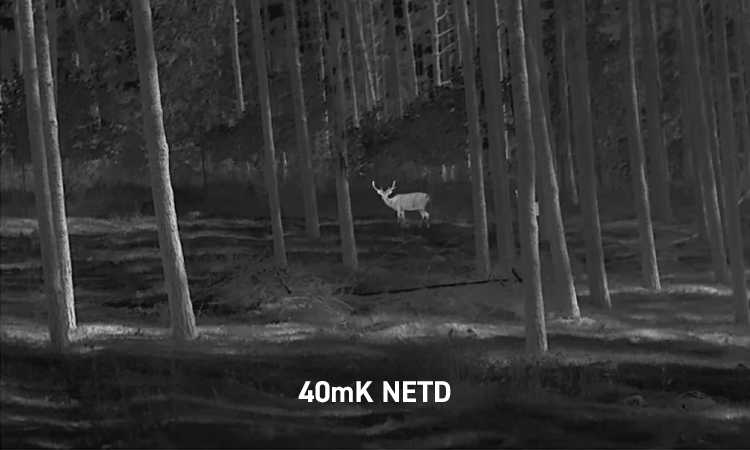
What is Micron? (Pixel Pitch)
Micron (µm) refers to the pixel pitch, which impacts image resolution and detail.
12 Micron vs. 17 Micron in Thermal Imaging
The main difference between 12-micron and 17-micron thermal sensors comes down to image clarity, range, and lens size:
- 12µm sensors offer higher resolution and longer detection range with smaller, lighter lenses. They’re ideal for detailed imaging and long-distance spotting but may consume more power.
- 17µm sensors are more light-sensitive and power-efficient but require larger lenses for the same level of detail. They work well in budget-friendly setups where sensitivity is a priority.
- For high-performance thermal imaging, 12-micron sensors are typically the better choice, especially for fieldsports and wildlife observation.
Why Does Refresh Rate Matter?
The refresh rate of a thermal camera, measured in Hertz (Hz), determines how quickly the image updates.
- Higher refresh rates (e.g. 50Hz) provide a smoother image with minimal lag, which is ideal for tracking fast-moving animals or scanning large areas while in motion.
- Lower refresh rates (e.g. 9Hz or 30Hz) may feel slightly slower and can result in motion blur, but they are still suitable for stationary observation or slow-moving wildlife - you will find this in older technology devices.
For activities like fieldsports or monitoring active wildlife, a higher refresh rate (50Hz) is recommended. All of the thermals available at Night Master feature a 50Hz refresh rate to ensure the smoothest image possible.

Speak to the Team
If you require further help with choosing the best thermal imager for your needs, please feel free to get in touch with a member of our friendly team on 01535 610066 or info@nightmaster.co.uk - we're available between 8am - 4:30pm, Monday to Friday (UK).



